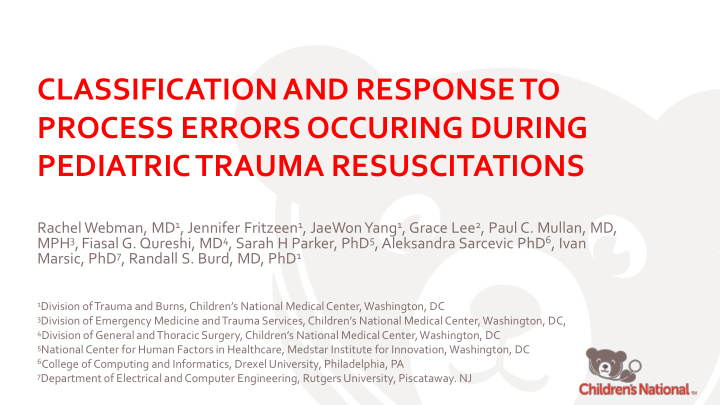



CLASSIFICATION AND RESPONSE TO PROCESS ERRORS OCCURING DURING PEDIATRIC TRAUMA RESUSCITATIONS Rachel Webman, MD 1 , Jennifer Fritzeen 1 , JaeWonYang 1 , Grace Lee 2 , Paul C. Mullan, MD, MPH 3 ,Fiasal G. Qureshi, MD 4 , Sarah H Parker, PhD 5 , Aleksandra Sarcevic PhD 6 , Ivan Marsic, PhD 7 , Randall S. Burd, MD, PhD 1 1 Division of Trauma and Burns, Children’s National Medical Center, Washington, DC 3 Division of Emergency Medicine and Trauma Services, Children’s National Medical Center, Washington, DC, 4 Division of General and Thoracic Surgery, Children’s National Medical Center, Washington, DC 5 National Center for Human Factors in Healthcare, Medstar Institute for Innovation, Washington, DC 6 College of Computing and Informatics, Drexel University, Philadelphia, PA 7 Department of Electrical and Computer Engineering, Rutgers University, Piscataway. NJ
ERROR ERROR Mitigation Patient condition Luck ADVERSE NO EVENT HARM RARE FREQUENT
Objectives Identify and classify errors occurring during trauma resuscitations Evaluate error patterns and team response to errors
August 2014 Dataset 50 cases Lack of consent 4 cases 46 cases Poor quality/erasure 16 cases 30 cases
Video Review Process deviations Error Class • Process errors Selection • Commission • Omission
Error Classification Non-routine event Process error Process (potential harm) deviation High risk for Low risk for potential harm potential harm Innovation/ acceptable variation No team response Team response
Error Classification Non-routine event Process error Process (potential harm) deviation High risk for Low risk for potential harm potential harm Innovation/ acceptable variation No team response Team response
Error Classification Process error (potential harm) Omission Selection Commission
Data Analysis χ 2 test for comparison of response between error categories Pearson’s correlation coefficient used to assess error association with process deviations
Results Summary Statistics All activations (n=30) Age, years (mean ± SD) 8.7 ± 0.9 Male (%) 86.7% Penetrating mechanism (%) 3.3% ISS>15 6.7% Activation level Stat 60.0% Transfer 40.0% No pre-notification 10.0% Weekend event 53.3% Daytime event (7 AM-7 PM) 46.7% Adverse events 0%
Results Summary Statistics All activations (n=30) Age, years (mean ± SD) 8.7 ± 0.9 Male (%) 86.7% Penetrating mechanism (%) 3.3% ISS>15 6.7% Activation level Stat 60.0% Transfer 40.0% No pre-notification 10.0% Weekend event 53.3% Daytime event (7 AM-7 PM) 46.7% Adverse events 0%
Results Error Classification Error type # of occurrences (% of total) Average # per resuscitation All 250 8.3 Error Class Commission 97 (38.8) 3.2 Selection 95 (38.0) 3.2 Omission 58 (23.2) 1.9 Harm Potential High risk 98 (39.2) 3.3 Low risk 152 (60.8) 5.1
Results Error Type by Phase 60 Commission 50 Process Error (n) Selection 40 Omission 30 p=0.17 20 10 0 Preparatory Primary survey Secondary Survey Post-resuscitative
Results Team Response Error type Team Response All (n=250) 121 (48.4%) Error Class Commission (n=86) 46 (53.5) Selection (n=95) 33 (34.7) Omission (n=69) 42 (60.9) Harm Potential High risk (n=98) 34 (35.8) Low risk (n-152) 60 (39.5)
Results Comparison of Response 100% 39.1% 80% 42.5% 65.3% 60% No response No Response 40% Team response Response 60.9% 53.5% 20% 34.7% 0% Commission Selection Omission Commission Selection Omission
Results Comparison of Response p<0.001 p=0.02 100% 80% 60% No No response 40% Response Team response 20% 0% Commission Commission Selection Selection Omission Omission
Results Comparison of Response p=0.36 100% 80% 60% No response No 40% Response Team response 20% 0% Commission Selection Omission Commission Selection Omission
Results Comparison of Response p=0.36 100% 80% 53.9% 57.9% 60% No Response 40% Response 46.1% 42.1% 20% 0% High risk Low risk
Results Relationship Between Process Errors and Non-Error Deviations Correlation coefficient 0.24 p-value 0.20
Summary Adverse events are not common Errors during trauma resuscitations are common Trauma teams respond to half of the process errors Trauma team response differs between error classes
Limitations Single institution Small sample size with few severely injured children Subjective evaluation potentially subject to bias
Implications Errors not associated with patient morbidity are frequent and should be studied to identify risks of and methods for prevention of adverse outcomes
Recommend
More recommend